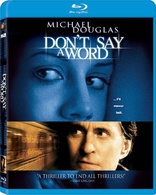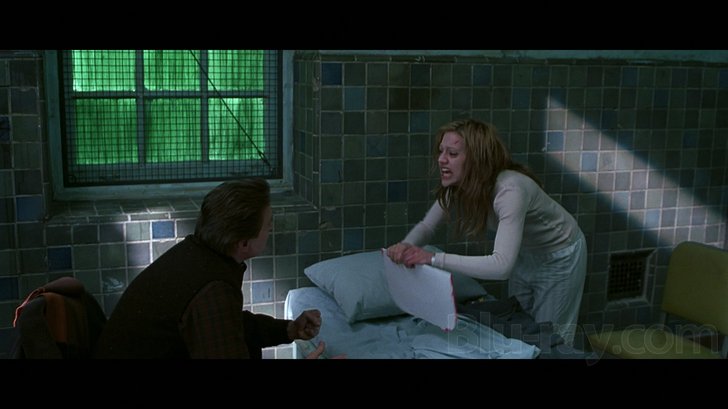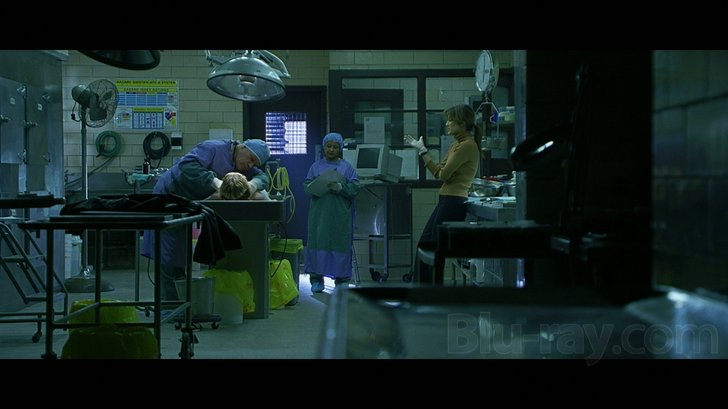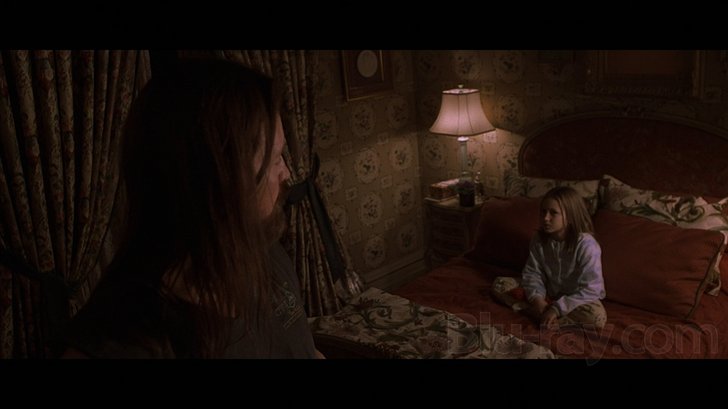Don't Say a Word Blu-ray Movie
HomeDon't Say a Word Blu-ray Movie 
20th Century Fox | 2001 | 113 min | Rated R | Sep 13, 2011
Movie rating
6.1 | / 10 |
Blu-ray rating
| Users | 4.5 | |
| Reviewer | 4.0 | |
| Overall | 4.1 |
Overview
Don't Say a Word (2001)
A group of thieves steal a rare gem, but in the process, two of the men double cross the leader of the thieving group, Patrick, and take off with the precious stone. Ten years later, prominent psychiatrist Nathan Conrad is invited to examine a disturbed young woman named Elisabeth. Patrick immediately kidnaps Nathan's daughter, forcing Nathan to attempt to get Elisabeth to reveal a secret number which will ultimately lead Patrick to the whereabouts of the precious gem that has eluded him.
Starring: Michael Douglas, Sean Bean, Brittany Murphy, Skye McCole Bartusiak, Guy TorryDirector: Gary Fleder
| Psychological thriller | Uncertain |
| Thriller | Uncertain |
| Crime | Uncertain |
Specifications
Video
Video codec: MPEG-4 AVC
Video resolution: 1080p
Aspect ratio: 2.35:1
Original aspect ratio: 2.39:1
Audio
English: DTS-HD Master Audio 5.1 (48kHz, 24-bit)
Spanish: Dolby Digital 5.1 (448 kbps)
Spanish: DTS 5.1 (48kHz, 24-bit)
French: DTS 5.1 (48kHz, 24-bit)
French (Canada): Dolby Digital 5.1
Portuguese: Dolby Digital 5.1
Russian: DTS 5.1
Czech: Dolby Digital 2.0
Hungarian: Dolby Digital 5.1 (448 kbps)
Polish: Dolby Digital 5.1
Thai: Dolby Digital 5.1
Turkish: Dolby Digital 2.0
Corrected from disc; DO NOT CHANGE
Subtitles
English SDH, French, Portuguese, Spanish, Bulgarian, Cantonese, Croatian, Czech, Danish, Dutch, Finnish, Hebrew, Hungarian, Icelandic, Mandarin (Simplified), Mandarin (Traditional), Norwegian, Polish, Romanian, Slovenian, Swedish, Thai, Turkish
Discs
50GB Blu-ray Disc
Single disc (1 BD)
Playback
Region free
Review
Rating summary
| Movie | 3.5 | |
| Video | 4.0 | |
| Audio | 4.5 | |
| Extras | 4.0 | |
| Overall | 4.0 |
Don't Say a Word Blu-ray Movie Review
She Stole the Picture
Reviewed by Michael Reuben September 22, 2011When Brittany Murphy died in December 2009 at the age of 32 (of a combination of pneumonia, anemia and, possibly, drug use), it was not a surprising development. The actress had so often and so effectively portrayed fragile, damaged creatures on screen that her being one in real life seemed only natural. (I know the artistic director of a theater company where Murphy performed who tells stories of her literally needing medical attention after each performance.) While Clueless remains her best comedy work, the eerie convergence between art and reality resulted in Murphy's finest dramatic performance in the 2001 thriller, Don't Say a Word. Even when the film was first released as a Michael Douglas film, it was Murphy's portrayal of a traumatized mental patient that everyone noticed. Watching the film today, the knowledge of how little time the actress had left adds weight to the performance, because it intensifies the question hanging in the air at the end of the film: how can Murphy's Elisabeth Burrows find her way back from the terrors she experienced as a little girl and everything she's had to do to protect herself since then?

The McGuffin that drives Don't Say a Word is a bank robbery, but not just any bank robbery. In 1991, a group of armed men led by Patrick Koster (Sean Bean) rob a Brooklyn bank using precision timing and high-tech equipment to steal a single item from a particular safe deposit box: a rare blood-red diamond. It's never explained how the gang knew about this stone or its location, but at a later point in the film, a cop refers to Patrick as "a ghost", which suggests a background in intelligence. Part of Patrick's mystique as a villain is that we never really know. During the robbery, two of Patrick's men double-cross him. One of them, Russel (Shawn Doyle), swaps the diamond for a worthless bauble and disappears with his confederate. Patrick is not pleased. Ten years later, we meet Dr. Nathan Conrad (Michael Douglas), a successful Manhattan psychiatrist. It's the evening before Thanksgiving, and Nathan is returning home from his office to his apartment in the Ansonia on upper Broadway, where his eight-year-old daughter, Jessie (Skye McCole Bartusiak), and his wife, Aggie (Famke Janssen), eagerly await him. Nathan has to do the shopping for Thanksgiving dinner, because Aggie is laid up in bed, her right leg in a cast and traction from a skiing accident. "The downhill racer", Nathan ribs her. (The Ansonia, by the way, is a real building, and it is exactly the kind of luxury locale where a successful psychiatrist would reside.) But Nathan is diverted en route by a page from a former colleague, Dr. Louis Sachs (Oliver Platt), at Bridgeview Psychiatric Hospital. Insisting that it's an emergency, Sachs asks Nathan to examine a patient just transferred to Bridgeview after she attacked an orderly at an upstate facility. Nathan used to be good with such cases, and if someone can't reach her, she'll be locked away permanently. Nathan would rather go home, but he's already there; so he agrees to see Elisabeth Burrows (Murphy). He quickly spots that the wild-looking creature is faking her symptoms. (He'll later discover that she's successfully faked and been misdiagnosed with a dozen conditions over the years.) "There's more to you than meets the eye", he tells her, but just as he's leaving, she speaks. "You want what they want", she says calmly. "Who are they?" he asks. Her sing-song answer became a catchphrase: "I'll never tell." Nathan goes home to his family, but the next morning he finds his front door forced open and his daughter missing. When he picks up the phone to call the police, the line is dead except for a voice that we recognize as Patrick Koster's telling Nathan that has until 5:00pm to get Elisabeth Burrows to divulge a certain number or they'll kill his daughter. If there's a criticism to be made of director Gary Fleder's thriller, it's that the action from this point becomes increasingly complicated, playing out in two time periods and multiple locales, often simultaneously. Indeed, by the time Patrick calls Dr. Nathan, a police detective, Sandra Cassidy (Jennifer Esposito), is already hot on his trail, because Patrick and his cohorts have left a trail of bodies for Cassidy and the long-suffering coroner (Victor Argo). As Fleder acknowledges at several points in his commentary, editing the film was a huge challenge, because it required balancing and coordinating Cassidy's investigation, Nathan's efforts to save his daughter (which take him to all sorts of unexpected places), the activities of the kidnappers (who, among other things, never counted on how resourceful a little girl can be, especially a shrink's daughter), Aggie Conrad's determination to do something, and several other elements best left for the first-time viewer to discover. The advantage of such complexity is that the film stands up to repeat viewing, because the editors did their job well and the pieces fit (more or less). It helps that the performances are so good. Douglas has always done his best work playing men who are something of a rogue, which is precisely what Nathan Conrad must become during the course of the film, if he wants to save Jessie. The scene where he has to get Elisabeth out of Bridgeview past a guard played by Lance Reddick (currently the ramrod head of Fringe Division on Fringe) is particularly good, as is his final face-off with Patrick. Janssen's refusal to make Aggie Conrad a damsel in distress makes her determination to protect her child fierce and palpable, even when she can't move. And Bean creates a chilling villain. They should book him if there's ever another Die Hard. But Murphy's Elisabeth eclipses them all. The mixture of rage, anguish and desperation with which she initially repels Nathan Conrad is movie acting at its rawest. There's nothing phony or "actorly" about it, and it burns a hole in the screen. Then, when Nathan persuades her to drop her guard, the real Elisabeth emerges: a child in an adult body, condemned to relive in an endless loop a traumatic experience that holds the key to everything. You can literally see Douglas stepping back as he and Murphy do those scenes together. Douglas is a smart actor. He knew who everyone would be watching.
Don't Say a Word Blu-ray Movie, Video Quality 

The cinematographer of Don't Say a Word was the Iranian DP Amir Mokri, who began his career in the Eighties on small films for such arthouse directors as Wayne Wang and (at the time) Kathryn Bigelow, then graduated to big-budget fare (most recently the third Transformers film for Michael Bay, for whom he also shot Bad Boys II). Working at the tail end of the photochemical era, Mokri created three distinct looks for the film. For the robbery prologue, he used "bleach bypass" processing to desaturate the negative and create an appearance signifying a past event. For Elisabeth's childhood memories, he used reversal stock to obtain intense colors and rough, almost harsh images, because these are not happy memories. For the rest of the film, Mokri used standard 35mm film, but he used washes of tint to distinguish between cold, antiseptic environments, such as Elisabeth's room at the Bridgeview facility or the coroner's office, and warm locales like the Conrad apartment. The 1080p, AVC-encoded Blu-ray reproduces these varied colors and textures faithfully, with excellent detail and black levels that accurately present Mokri's carefully balanced shadows. (In his commentary, director Fleder penitently notes a shot where he overruled his DP by insisting that Michael Douglas' face be fully lit, then decides he was right after all.) Grain is faintly present if you look for it, but this is overall an elegantly smooth image, even in the reversal stock footage, which is more likely to display blown-out whites than grain (and that's a deliberate effect). I did not detect compression artifacts, DNR, ringing or any other distortions. This is often a dark image, but it's a very good one.
Don't Say a Word Blu-ray Movie, Audio Quality 

Fleder says in his commentary that he believes in using sound to convey the subjective state of characters, and that he encourages his sound designers to add sounds that aren't there. This philosophy is evident before the film's first image appears, as the sounds of the subway fill the surrounds, because the subway plays a crucial role in Elisabeth's memory. Another notable example occurs when Nathan first realizes his daughter is missing and rushes out onto his apartment terrace; the cacophony of the city surrounds him when he first steps outside, but in reality it would be part of the continuum of sound long before he reached the terrace door. The Blu-ray's DTS-HD MA 5.1 track reproduces these and many other immersive effects with power and presence. Subways, power boats and various excavations provide interesting opportunities for sound design, as a does a trip into Chinatown. Dialogue remains clear throughout, and Mark Isham's score is well-reproduced. (As Fleder points out, Isham's score is crucial at the end of the second act, where the story cuts back and forth among several different chains of events, and the score serves as the common thread holding them together.)
Don't Say a Word Blu-ray Movie, Special Features and Extras 

Unless otherwise indicated, the video on all special features (other than commentaries) is standard definition at 1.33:1.
- Commentary by Director Gary Fleder: Fleder speaks continuously throughout the film, and he is an engaging speaker. He begins by noting that he is recording the commentary on October 12, 2001, and that the film was released in theaters on Sept. 28, after much debate among the filmmakers and the studio about whether to postpone release in light of the events of 9/11. Ultimately, they went ahead, but Fleder himself made the decision to replace certain shots of New York in the earlier part of the film, when the audience would be "settling in" with the story, so that the Twin Towers did not appear. They still appear in later shots, when the plot has already gained momentum. Fleder covers a wide variety of subjects, including script development, casting, the limited prep time for this particular film (which precluded any rehearsal), his approach to directing, his influences (for this film, he especially looked to Marathon Man and the original The Taking of Pelham One Two Three) and what Fleder calls "the magic of film" in mixing footage shot months apart in different locations. (The film was shot in New York and Toronto.) Fleder's approach to editing is unusual. He despises "rough cuts", preferring to edit as he shoots (which is why he needs two editors), so that he finds out immediately if he's missing something. When production wraps, he and his editors are ready to begin fine-tuning. With optional French or Spanish subtitles.
- Scene Specific Actor Commentaries
- Michael Douglas: "First Meeting" & "Lost Child": Douglas discusses his history with the project, working with Fleder and acting with Murphy and Janssen.
- Sean Bean: "Heist" & "The Trench": Bean's two scenes occur at the beginning and end of the film. During the first scene, he talks about his approach to Patrick Koster (and villains generally). During the second, which was one of the few he shared with Douglas in person (instead of over the phone), he discusses that interaction.
- Famke Janssen: "The Phone Call" & "Escape": Janssen says she did the film to work with Douglas, but comments on Sean Bean's generosity in supplying a performance at the other end of the telephone line. She also discusses the challenge of playing a character who is immobilized.
- Brittany Murphy: "Connection" & "Subway Nightmare": It's fascinating, even a little eerie, to hear Murphy describe playing Elisabeth as "freeing", but her description of how characters take her over is consistent with both Fleder's and Douglas' description of her instinctive acting process. Murphy makes an astute point when she notes that there are three versions of the character: the one she reads in the script, the one she experiences during filming, and the one she sees in the completed film.
- Oliver Platt: "Office Intrustion" & "Confrontation": Platt discusses working with Douglas and some of the finer points of his Sachs character.
- Making Of Featurette (7:55): This is more informative than the usual EPK, and since it has substantially more spoilers, one would hope that it wasn't used for pre-release publicity. It contains interesting on-set footage as well as interviews with Fleder, Kopelson, Douglas, Murphy, Janssen and young Skye McCole Bartusiak.
- Cinema Master Class
- Pre-Production
- Screen Test: Brittany Murphy (6:28): Murphy reads opposite Douglas, and the result is ever bit as riveting as in the finished film.
- Storyboard to Screen Comparisons (10:07): Two scenes are included: the bank heist and potter's field.
- Producing Workshop with the Kopelsons (7:32): Arnold and Anne Kopelson discuss their long history of producing movies (including Platoon, The Fugitive and Se7en).
- Production
- You Are There (7:47): These short features focus on production design, using on-set footage with picture-in-picture commentary by Fleder. Three sets are discussed: the hospital, the subway and the boat dock.
- Screening Room Dailies: Aggie Escapes (SD; 2.35:1): Nine takes are includes, along with the fifty-second completed scene from the film. For some reason, there is no "play all" feature, so that each angle must be selected and played separately.
- Set Tour with Production Designer Nelson Coates (5:42): The amiable production designer points out details of the elaborate Conrad apartment set (built on a Toronto soundstage); the Toronto subway station dressed to recreate the Canal Street IRT stop circa 1991; and a complex soundstage design simulating a portion of a huge graveyard.
- Post-Production
- Conversation with Director Gary Fleder (7:01): For some reason, although this featurette is included under "Post-Production", the bulk of the conversation is about acting and how Fleder deals with actors on the set.
- Thriller Themes (5:18): Fleder discusses his work with Mark Isham, but the bulk of this feature is simply a split screen of a scoring session and the scene from the film that is being scored.
- Inside a Sequence: Trench Sequence (1:43): Storyboards and animated "pre-vis" footage of the film's most demanding action sequence.
- Deleted Scenes (SD; 2:35:1, non-enhanced; 3:00): There are three short, minor scenes, of which perhaps the most interesting is the one that indicates Patrick's history of claustrophobia.
Don't Say a Word Blu-ray Movie, Overall Score and Recommendation 

It's sad to listen to commentaries and interviews recorded in 2000 and 2001 praising Brittany Murphy and predicting her bright future. She continued to work, but she never again appeared in the kind of dramatic role of which she was clearly capable, and none of the comedies she made after this film used her talents to the full extent. That her finest work was delivered in what amounts to a glossy "B" movie shouldn't diminish the achievement. The film is highly recommended, and so is the Blu-ray.
Similar titles
Similar titles you might also like

Kiss the Girls
1997

Along Came a Spider
2001

Final Analysis
1992

Cellular
2004

Gone
2012

Inside Man
2006

A Perfect Murder
1998

The Brave One
2007

21 Bridges
2019

Bandit
2022

No Good Deed
2002

A Stranger Among Us
1992

Obsessed
2009

Blackmail
1929

Experiment in Terror
1962

Bullets or Ballots
1936

Best Laid Plans
1999

The Captive
2014

Confidence
2003

Flightplan
2005